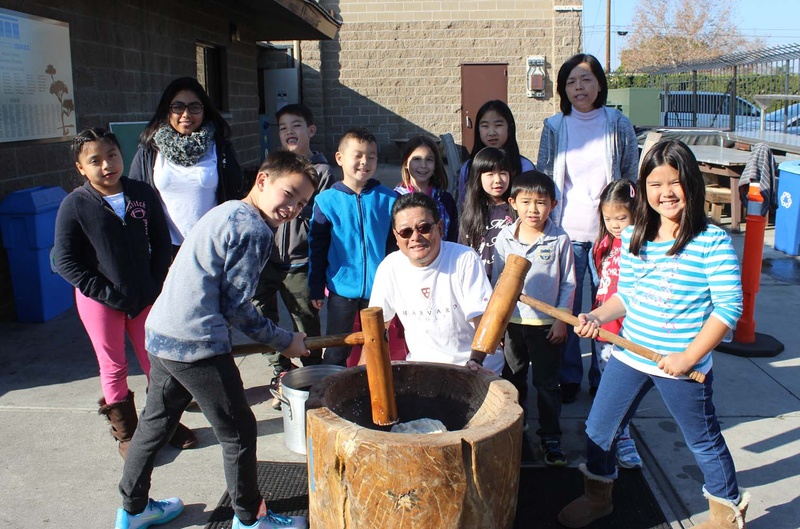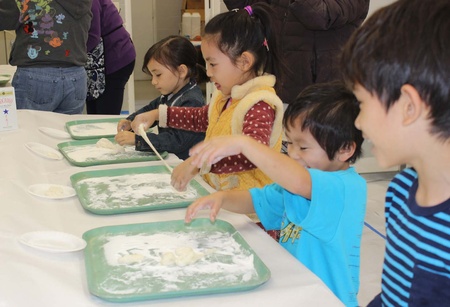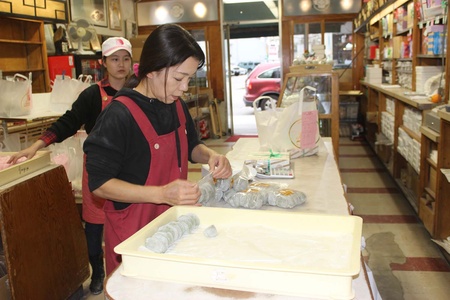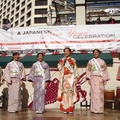How many nights will we sleep before oshogatsu?
Let’s fly a kite and
spin a top on oshogatsu...♪♪
This song is called Oshogatsu. It’s composed by Rentaro Taki and written by Kume Higashi. It’s a famous oshogatsu song that most Japanese learn in elementary school. It might be because I’m living abroad, but in December, I find myself longing for “oshogatsu,” not “New Year.”
“New Year” and “oshogatsu” are different in how I feel them. “New Year” in America has its highlight at the countdown from the eve on December 31 to January 1. And once it’s a new year, I feel a bit sad as there’s only one day left in the holiday season. On the other hand, oshogatsu gives me a feeling of freshness and dignity, as I wait for the new year listening to the bells on New Year’s Eve, see the first sunrise of the year, pay the first visit of the year to a shrine, and freshly start the new year, making new plans on New Year’s Day as in the saying, “Planning for a year is to be made on New Year’s Day.”
For those living in Los Angeles, it’s nonsense to think that they need to give up on celebrating oshogatsu in Japanese ways simply because they are outside of Japan. Japanse immigrants lived in Los Angeles before the war, and many Japanese cultural events have taken place in their communities over generations with oshogatsu being one of the important events of the year.
Mochitsuki - mochi pounding
Mochi or rice cake is a must item for oshogatsu. In Nikkei communities, mochitsuki (mochi pounding) events take place in various places, such as Buddhist temples, Japanese language schools, and even Christian churches, starting in December.
At East San Gabriel Valley Japanese Community Center (ESGVJCC) Gakuen in West Covina city, all students learning Japanese, from those in kindergarten to high school make mochi with a pestle. They call out in Japanese, “ichi, ni, san, shi,” the numbers they learned at the school, and bring the pestle down to the mochi in a mortar in a rhythmic pace. As it takes some courage to bring the pestle down from a high position, few students are willing to try. Most of them bring it down from close to the mortar and pound the mochi gently. Once it’s done, they tear the mochi into bite-sized pieces and make them round with mochi powder. If the powder is not enough, the soft mochi gets stuck on their hands and stretches. Small children are very excited with this stretching food. The round mochi done with hard work is completed with different “sauces” such as sweet bean paste (anko) or soybean powder (kinako). Time to eat now!
At West Covina Christian Church, mochitsuki takes place on the second Saturday of December. Members take mochi making machines to the church and make round mochi. Normally English and Japanese-speaking members attend a service separately, but they make mochi together on this day. The church purchases sticky rice (mochigome) and gives it out to the members beforehand. Each member soaks the rice in water at home and takes it to the church on the day of mochitsuki. They measure the mochigome and water using a cup and put them in mochi making machines. They have about 10 machines placed in multiple parts of the church to prevent blowout, then they turn the switches on.
The mochi making that starts at 6:30 a.m. continues until around noon. The mochi making machines keep making mochi, but the machines do get overheated after they have been used twice or three times, so they get a break. It’s around this time when Japanese-speaking members’ ozoni (a soup dish that contains rice cake and vegetables) is given out.
In the courtyard, mochitsuki takes its traditional form with a concrete mortar. Here most of the members are young and/or male. Sansei Clara Furukawa from Hawaii is one of the organizers of this mochitsuki. “Sometimes our members say we should stop doing this because preparation for mochitsuki is too much work. But I want young Japanese Americans to learn about Japanese cultures, so I want to keep doing this as long as we can,” she says.
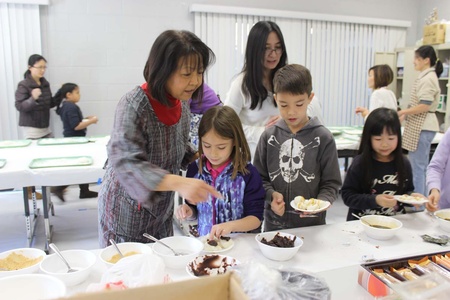
Mochitsuki at Japanese confectionery in Los Angeles
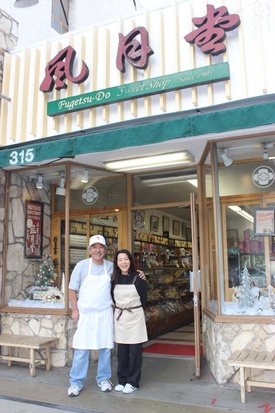
Home-made mochi is hard work whether you are in Japan or in America. In fact, most people get their mochi or okasane-mochi (piled mochi) at Nikkei supermarkets or at Japanese sweets stores. Fugetsudo is a Japanese confectionery in Little Tokyo in downtown Los Angeles with over 100 years of history. At the store, making of small mochi and okasane-mochi peaks from December 28 to 31.
Traditionally it’s said that okasane-mochi should be placed as part of oshogatsu decoration starting December 28. This is because the number 8 in kanji is associated with good luck. Okasane-mochi refers to kagami (mirror) mochi, and according to Japan Kagami-mochi Association, “Kagami-mochi that is made as offerings for oshogatsuuses the newly harvested rice from that year. It’s believed that the spirit of pure rice is in the pounded and hard rice cake. So kagami-mochi is said to be the offering that has the spirit of the god of age or that has the power to age.” The shape of kagami-mochi is said to have come from a mirror, one of the three sacred treasures from Amaterasu-omikami god. Some Americans call it a “cute snowman” but in fact okasane-mochi is a very sacred kind of mochi.
At Fugetsudo, they start making okasane-mochi in the midnight of December 27. Okasane-mochi goes bad quickly and can easily get cracks in the dry weather in California. They take two mochi that are different in size, place the smaller one on top of the other and make sure that it looks good. As the mochi needs to be rested for one night, they make it in the midnight. It’s a simple yet very delicate mochi.
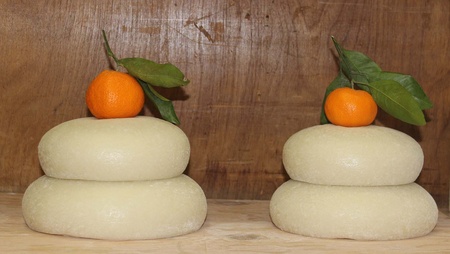
Small mochi can be eaten as ozoni or as isobe-yaki (grilled mochi in soy sauce wrapped in nori seaweed). According to Tomoko Kito, wife of the third-generation owner of Fugetsudo, packing of small mochi in bags is the hardest part of oshogatsu preparation. “It’s endless. We keep packing and packing, but there are plenty of more mochi to be packed. We work on this all day long.” From December 29 to 31, volunteers come to the store at around 11 p.m. and they keep packing mochi all night long.
This volunteer work at Fugetsudo was started by Nancy Kikuchi about ten years ago when she said “Let’s help to pack small mochi at Fugetsudo.” She had done various volunteer work in Nikkei communities. Nancy asked her friends and acquaintances, got about ten volunteers and arranged their work schedule. Before the volunteers came, Tomoko packed the mochi as she took care of her baby child in a stroller every year. “I’m very grateful for the volunteers,” she says. Nancy passed away from cancer last year, but Gail Matsui took over the work and Fugetsudo volunteers are still active this year.
Fugetsudo does not close at all for three to four days before the new year. They keep making mochi behind the closed counters. They pack small mochi throughout nights, and the professionals start working at 5 a.m. in the morning. Third-generation owner Brian Kito devotes all energy to making mochi throughout this time without going home, so he stays at a hotel in Little Tokyo.
“I start feeling oshogatsu when the store gets filled with the smell of rice all day long. I’m like, oh it started… To me the smell of rice is sacred. We still have some time to spare on the 27th and we start running on the 28th. On the 30th, we are exhausted,” says Tomoko.
They make special products for oshogatsu, but the employees have a hard time processing them, as it only happens once a year. Tomoko says that she gets super careful with processing orders right.
“Oshogatsu is a special thing for each and every one of our customers. We can’t make mistakes as they order things for their special plans. If we make mistakes, it will ruin their whole year. We can’t let that happen. It takes about one week to place some products like yokan (sweet bean jelly) in store, so starting in November I tell my staff repeatedly that they can’t make mistakes with orders. We really have to take them seriously.”
On New Year’s Eve, when people in the communities are settled for the new year, Fugetsudo finally finishes their last work of the year. With his appreciation, Brian waits for the new year as he places the okasane-mochi at the store that has run a full year with him.
Tomoko on the other hand, does some grocery shopping for oshogatsu and starts preparing for oshogatsu for the Kito family when she gets home. As the family celebrates the New Year on January 1, Tomoko makes osechi and ozoni. “I don’t do anything for Thanksgiving and Christmas because Brian’s sisters do everything. So oshogatsu is my thing.” Believe it or not, she finishes making the feast in the early morning of New Year’s Day. After getting some sleep, she heads for the New Year’s celebration.
For both Japanese Americans and the Japanese in Nikkei communities in Los Angeles, oshogatsu does not translate into “New Year.” It’s a special event that marks the start of a year.
© 2017 Tomomi Kanemaru


